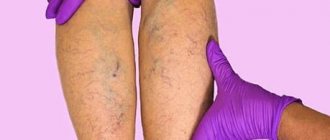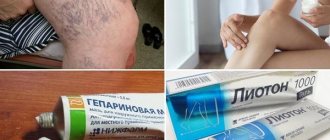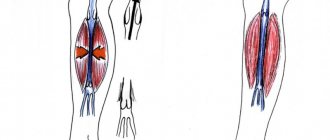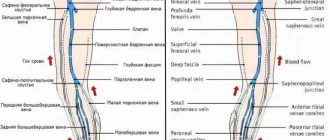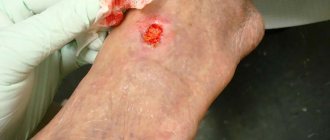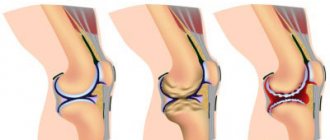The first signs of the development of varicose veins are often attributed to ordinary fatigue, a trip to the doctor is ignored, and they continue to lead their usual lifestyle, aggravating the condition of the veins. Complications with varicose veins develop very quickly. Mostly those who require surgical intervention come to the specialist. Until this moment, everyone is trying to cure themselves with the help of tinctures and tablets.
How not to bring yourself to a deplorable state and take the necessary measures in time? First, you need to understand when you need to see a doctor. Secondly, go to the doctor as soon as you realize it’s time. This is not a case where you should wait a little and see what happens to the veins. Any delay can cost you dearly. The article contains descriptions of the signs of different types of varicose veins, which will help determine whether you suspect the disease.
Why do varicose veins appear?
If you know the causes of varicose veins, you can protect yourself in time by taking preventive measures.
Heredity. If one of your relatives suffers from varicose veins, then there is a chance that you will have it too. Varicose veins themselves are not inherited, but you may inherit structural features of the veins or, for example, a tendency to be overweight, which will affect the occurrence of problems with the veins.
Pregnancy. During pregnancy, a woman's body produces an increased amount of progesterone, which relaxes the walls of the veins. They can't do their job and the blood stagnates. Also during pregnancy, a woman’s body weight increases and the amount of circulating blood increases, which increases the load on the veins.
Overweight. Large body weight creates a constant load on the lower limbs. It is more difficult for the veins to supply blood to the heart and lungs, the blood stagnates, and the veins dilate. As a result, venous expansion of the veins occurs.
Wearing uncomfortable clothes and shoes. If the shoes are too narrow and tight, it prevents blood from circulating normally in the legs. The same goes for clothes that are too tight.
Elderly age. Age-related negative changes occur in the walls of blood vessels. They lose their elasticity, the vessels stretch and blood accumulates and stagnates in them.
How to diagnose varicose veins
- Using functional tests (application of a tourniquet), the condition of the valves is studied. They are named after the authors - Troyanov-Trendelenburg, Pratt, Sheinis, Delbe-Perthes, etc.. For the Troyanov-Trendelenburg test, you need to lay the patient horizontally, then offer to raise the leg 450. In this position, the doctor strokes the limb from the foot upward to empty the superficial veins. The next step is to apply a tourniquet to the upper half of the thigh, after which the patient rises from the couch. Healthy veins in the legs should fill up after 15 seconds.
- Duplex ultrasound scanning of veins (ultrasound angioscanning) provides the most information and allows you to visualize the vessels and blood flow through them.
- Dopplerography is a method for assessing blood circulation through vessels.
- Phlebography or X-ray examination using contrast, which helps to study the internal structure of the vessel.
- Phleboscintigraphy is a technique using radioactive substances with further study on a special device for their distribution.
To study the superficial veins, they are examined and palpated. The first three methods are used as additional examinations. The last two methods are necessary to study the condition of the deep or deep veins.
How to understand that varicose veins are developing on the legs
Many people believe that the first signs of varicose veins are spider veins, swollen areas of veins and other external manifestations. But the pathology is very insidious and for a long time disguises itself as ordinary fatigue of the lower extremities, without revealing itself from the outside.
Get an online consultation
right now.
Get
Signs of the development of varicose veins that you need to pay attention to:
- Frequent muscle cramps. Since the blood does not circulate in the required mode through the veins, it stagnates and, as a result, oxygen starvation of the tissues. These factors lead to seizures.
- Unhealthy skin color on legs. Lymph and blood do not circulate well in the affected areas of the lower extremities. The skin color here becomes lighter with dark spots. As the disease progresses, these spots begin to become red, swollen, and itchy. If treatment is not started, the likelihood of trophic ulcers increases significantly.
- The legs and ankles begin to itch for no reason . In the vessels that are adjacent to the skin, transformations occur due to stagnation of blood and lymph. Metabolic products are not removed from these areas properly, which leads to itching, burning, peeling of the skin of the legs and its excessive dryness.
- Tingling, numbness of the limbs. At the initial stage of varicose veins, the feet may become numb for no reason. The patient will feel a tingling sensation. These symptoms arise due to poor functioning of the joints and tissue hypoxia. Normal motor activity is disrupted because the tissues lack interarticular fluid. If numbness becomes regular, then you should not postpone a visit to the doctor.
- Swelling . When the valve does not work at full strength, fluid accumulates in the intercellular space and swelling occurs. People prone to varicose veins are recommended to measure the volume of their legs in the morning and in the evening. A reason to sound the alarm and visit a phlebologist will be a change in indicators of 1 cm upward in the evening.
- Pain in the legs after a static position. If a person sat or just stood for a long time, and after that the lower limbs began to hurt and “hum,” then it is worth paying special attention to this factor.
At the final stages, dilated veins clearly appear on the skin of the lower extremities against a background of swelling and pain. During the period of decompensation in the last stages of varicose veins, signs of thrombophlebitis and trophic ulcers may appear.
Diagnostics
Diagnosis of varicose veins, the symptoms of which are described above, poses the following tasks:
- Determining the presence of pathology in each individual patient. It often happens that people who do not have varicose veins are confident in their presence, and vice versa. However, only an experienced phlebologist, based on an external examination and a series of comprehensive studies, can make an accurate diagnosis.
- Establishing the type characteristic of venous pathology. The doctor determines exactly which veins have undergone pathological damage, and also establishes the extent of this damage and possible or already occurring consequences.
- Prescribing the correct course of treatment. Based on the diagnosis and the characteristics of each specific organism, the attending physician makes a choice in favor of one or another treatment or a set of therapeutic measures.
- Assessment of the level of effectiveness of therapy, which is carried out by the attending physician during the elimination of the disease or after the patient’s complete recovery.
The main methods for diagnosing VV include:
- Plethysmography.
- Thermography.
- Magnetic resonance imaging.
- Ultrasound angioscanning.
- Computed tomography.
- Clinical studies: conversation with the patient, his external examination and manual examination.
- Radionuclide phlebography.
- Intravascular ultrasound.
- X-ray phlebography.
Most often, it is enough for a professional specialist to conduct a clinical examination and ultrasound angiography in order to diagnose varicose veins in the legs. At the Yuzhny clinic, you can undergo a full examination in order to make an accurate diagnosis by an experienced phlebologist. Our specialists work closely with clients, clearly explaining to each of them the specifics of the disease and possible ways to combat it.
Why is reticular varicose veins considered a mild form?
Varicose veins of the lower extremities have a separate type - reticular varicose veins. It is common mainly among women and is considered a mild form of varicose veins because in this case only the thin veins dilate.
Reticular varicose veins are often called cosmetic, since the main symptoms are external manifestations in the form of spider veins on the calves and thighs. Reticular varicose veins occur most often due to wearing high-heeled shoes, severe physical activity and taking hormonal pills.
Despite the fact that reticular varicose veins are mild, they need to be treated to avoid possible complications. Treatment of pathology of this type is carried out with the help of ointments, gels, venotonic nature, drug therapy, laser. Traditional surgical operations performed with a laser, especially a scalpel, are very rarely used.
What are the symptoms of pelvic varicose veins?
If venous blood stagnates in the pelvic area, this can lead to the appearance of varicose veins in this area. It can stagnate due to sedentary work, mechanical compression of the veins by the enlarged uterus, and uncontrolled use of hormonal drugs. The cause of the appearance of dilated veins in the pelvic area can also be poor nutrition, constipation, hernias, problems in the genitourinary area, pathologies in the pelvic organs, nervous disorders and insomnia.
Most often the disease occurs in women. Pregnant women and menopausal women are at risk. The pathology manifests itself as pain in the perineal area, which becomes more intense after hypothermia or a long stay in a sitting position. Also, venous tubercles form in the perineal area, the process of urination becomes painful, and unpleasant sensations are observed during and after sexual intercourse.
All these signs require immediate contact with a specialist, because without adequate therapy, varicose veins of the small pelvis are aggravated by complications: thrombosis, thrombophlebitis, trophic ulcers. Pathology is diagnosed mainly by ultrasound examination, if there are no external signs yet.
Symptoms depending on the stage of the disease
Of course, it should be noted that the stage of development of the disease, the rate of progression, and existing complications (such as decompensation of venous outflow, thrombosis, varicothrombophlebitis, trophic ulcers), which are purely individual for each patient, are of great importance. Depending on the above, the optimal treatment option is selected.
The leading symptoms of varicose veins of the lower extremities are: swelling of the legs at the end of the working day, reticular veins - visually dilated saphenous veins, telangiectasias (in colloquial language - “spider veins”). For a long time, varicose veins manifest themselves only as a cosmetic defect - the presence of reticular veins, varicose veins (varix, lat. - node), however, it should be noted that the further development of varicose veins leads to the appearance of much more formidable symptoms and complications, such as pain, swelling of the feet and legs, and in advanced stages can lead to pigmentation of the skin of the legs (usually the internal surfaces), trophic ulcers, thrombosis, and varicothrombophlebitis.
How to determine the appearance of varicocele
Varicocele is a purely male type of varicose veins, which is an expansion of the veins of the spermatic cord. Signs of varicocele include nagging pain and a feeling of heaviness in the groin area, shrinkage of one of the testicles, enlarged veins under the skin, and frequent urination.
Why does pathology occur:
- the valves of the spermatic cord veins do not work well;
- there is not enough connective tissue forming the venous wall;
- the valves of the spermatic cord and testicles are underdeveloped;
- disruptions in the process of formation of the inferior genital vein in the womb.
If a man has high abdominal pressure, often experiences constipation, spends a lot of time sitting or standing, or exposes his body to excessive physical activity, then the risk of varicocele increases significantly. This disease has three degrees of severity: at first the veins can only be palpated in a standing position, at the second stage the lumps can be palpated while lying down, and at the third stage the swollen veins of the spermatic cord on the testicle are visible to the naked eye.
The stage when the testicles are covered with numerous clusters of veins is considered final and requires emergency treatment. After all, neglected varicocele very often becomes the cause of male infertility, thrombosis, thrombophlebitis and other complications. Pathology is diagnosed using an external examination, ultrasound, MRI or CT. Adult patients are often prescribed a spermogram to determine sperm activity and exclude asthenozoospermia.
What are internal varicose veins
With internal varicose veins, it is not the superficial, but the deep veins that are affected. The usual external signs in the form of bulging veins and vascular networks are often absent. The pathology is manifested by soreness of the lower extremities, which is often mistaken for banal fatigue. Elderly people are susceptible to internal varicose veins, whose deep veins transform due to age-related changes, become less flexible and elastic, and the valve system suffers from wear and tear. If the pathology is not treated, ulcers form on the lower extremities, which are difficult to heal.
Team of Doctors
Internal varicose veins are very difficult to recognize in the initial stages. Therefore, everyone who has a genetic predisposition to this disease is recommended to undergo a preventive ultrasound at least once a year. Since the deep veins are surrounded on all sides by muscles, it is impossible to detect their deformation during visual inspection
Treatment of varicose veins
Conservative treatment options
- Drug therapy does not cure varicose veins, but with the help of drugs, valve function, vascular trophism, blood circulation are partially improved, and the risk of thrombosis is reduced.
For this purpose, venotonics are used (Detralex, Troxivazin, Lyoton gel, etc.). They can be prescribed for any type of varicose veins. Ointments with nonsteroidal anti-inflammatory drugs (Indomethacin, Diclofenac, etc.) are indicated for thrombophlebitis. Also in this situation, anticoagulants are used (Heparin, Clexane, Fraxiparine, etc.), which effectively resolve blood clots. Treatment should be selected by a doctor, after a thorough diagnosis and taking into account the characteristics of the patient. - Herbal medicine and additional techniques are of auxiliary value. It is advised to wear compression stockings, do gymnastics, skiing, cycling, and swimming. The “bicycle” exercise in a supine position, flexion and extension of the feet, gives good results; it improves the outflow of blood from the extremities. You can do the exercises if there are no complications. It is also recommended to take a contrast shower in the morning (water your leg first with warm water, then gradually reduce the temperature to cold). Cool baths with decoctions of oak bark, horse chestnut, chamomile, St. John's wort, rubbing the skin with tincture of white acacia flowers, Kalanchoe leaves, and apple cider vinegar help. Leeches help get rid of thrombophlebitis.
- Mode. You need to get out of bed slowly, 5-10 minutes. Your legs should be raised 10-15⁰ at night; to do this, place a cushion under your heels. You need to walk calmly, it is undesirable to cross your legs when sitting, and do not overwork. All patients are advised to wear compression stockings.
- You need to eat right, include coarse fiber and foods rich in vitamins in your menu. Citrus fruits, tomatoes, rose hips, black currants, nuts, legumes, liver, onions, eggs, and seafood will be useful. It is important not to drink alcohol, not to smoke, and to drink enough water during the day. For persistent constipation, it is recommended to drink a laxative.
Surgery
Phlebectomy or complete removal of veins
The indication for such a radical operation is varicose veins, which involve a large number of veins. At the same time, there are complications - trophic ulcers that are difficult to treat, thrombophlebitis, persistent swelling in the legs, general symptoms (fatigue, dizziness, fainting).
The operation is contraindicated in case of ischemic heart disease, severe infections, in very old patients, in the second half of pregnancy, in case of local inflammation of the legs (erysipelas, pustular rashes, eczema). Only surgery can radically rid the patient of varicose veins and restore the function of the valves. If the situation is too severe, untreated and neglected, this method of treatment remains the only one. The disadvantages of the intervention are the need to give anesthesia and keep the patient in the hospital for several days under observation, postoperative trauma with scars.
Laser therapy (endovascular microthermocoagulation)
Laser treatment of varicose veins is used if the pathology is combined with diseases of the cardiovascular system (CHI, hypertension), changes in peripheral vessels (phlebitis, thrombophlebitis), diseases of the respiratory system (asthma, chronic bronchitis, pleurisy), gastrointestinal pathologies (cholecystitis, ulcers, peritonitis ), nervous system (FM injuries, meningitis, encephalitis and their consequences), genitourinary system (inflammation of the kidneys, prostate, pathology of the uterus with appendages), with skin diseases (furunculosis, dermatitis, psoriasis, etc.).
Contraindications to the use of laser are oncology, decompensated pathology of the kidneys, liver, heart, cerebral sclerosis, pregnancy.
The main advantages of laser therapy are its effectiveness in eliminating dilation of superficial veins, speed (duration of manipulation is 15-20 minutes), no need to go to the hospital, and low trauma. Among the disadvantages, it is worth highlighting the poor accessibility of the technique; not all clinics have the appropriate equipment. Treatment is expensive and is of little use for severely affected and deep veins. If the laser is used incorrectly, you can get a thermal burn, and sometimes depigmentation occurs at the sites of exposure.
Radiofrequency coagulation (ablation)
The operation is indicated for extensive lesions of the saphenous veins, trophic ulcers resulting from long-term and untreated varicose veins.
Radiofrequency coagulation is contraindicated in acute thrombophlebitis, limited mobility of the patient, pregnancy, and mental disorders.
The main advantages of the method are its painlessness, absence of injury, and the need for hospital stay. Patients can return to normal activities the very next day.
The disadvantage is the high cost of the intervention.
Sclerotherapy
Indicated for varicose veins of small and large superficial veins (on large vessels it is carried out under the control of duplex Doppler ultrasound) in the initial stage and without complications. Pregnant and nursing mothers, allergies to drugs, deep vein thrombosis, infectious and inflammatory skin lesions on the legs are not treated with this method. The main advantages are low price, quick recovery, no need for hospitalization. The procedure leaves no marks and does not cause injury.
The disadvantage is the risk of the sclerosing drug entering a deep vein, reduced effectiveness upon contact with blood, and the ability to use only in the initial stages.
What does varicose veins of the foot look like?
At the very beginning of the development of pathology, one feels heaviness and fatigue in the legs by the end of the day. Next, aching pain may appear, a sensation as if the leg is bursting, and the foot swells. All these symptoms may go away on their own after rest. But you shouldn’t put off going to the doctor. If varicose veins of the feet are not treated at the initial stage, the disease will begin to progress. First, spider veins and spider veins will appear, then varicose veins will also affect large veins. At this stage, the pain becomes constant, the legs begin to swell more, and muscle spasms appear.
Prevention
Varicose veins on the legs, which are treated today using various methods, can be avoided by following preventive measures. Due to the fact that the risk of developing VV is much higher in women, it is they who need to not ignore the prevention of this disease. However, men should also not ignore preventive measures aimed at preventing the development of varicose veins in the legs. Key activities include:
- The use of local preparations (gels, ointments, creams) that help strengthen the walls of blood vessels, optimize the functioning of valves, reduce the risk of blood clots, eliminate swelling and heal wounds.
- The use of knee socks, tights, stockings and elastic bandages that have a compression effect. This is an excellent tool in the fight against varicose veins. These products can be purchased in specialized stores after consultation with a doctor, which is necessary due to the relative difficulty in independently determining the required type of compression garments.
- Specific exercises performed on a daily basis. They are able to stop even the dilation of blood vessels that has already begun. It should be borne in mind that if you have a tendency to BB, you will have to give up heavy physical activity, but in no case should you ignore an active lifestyle. For example, light jogging, swimming, yoga and skiing help maintain healthy leg veins.
- Preventive tablets for varicose veins are recognized as a more effective method of preventing VVs than the use of local drugs. However, any oral medication should be used only as directed and under the strict supervision of a competent specialist.
In order to prevent the situation from worsening, you should stop self-medicating at the first manifestations of the disease and consult a doctor. This will make it possible to make a correct diagnosis in a timely manner and prescribe adequate treatment, which will stop the progression of the disease and reduce to zero the risks of developing other pathologies.
Complications due to varicose veins
If treatment for varicose veins is not carried out or is carried out insufficiently, then sooner or later complications arise. These include venous thrombosis. A blood clot forms in the lumens of the vessel, which leads to thrombophlebitis. The vascular walls become inflamed, and the blood clot plays the role of a time bomb, because at any moment it can break off and clog vital arteries. Thrombophlebitis progresses especially quickly after infectious diseases, during air travel, difficult childbirth and complex surgical interventions.
Deep vein thrombosis of the lower extremities occurs very quickly. Literally within a few hours, inflammation occurs on the vein, the lower leg increases in size, swells, and acquires a bluish tint. At the slightest physical exertion, a person feels acute pain, but rest does not bring complete relief.
Trophic ulcers occur due to disruption of blood flow in tissues, resulting in necrosis and tissue rejection. First, severe swelling and burning of the skin appears. The legs become as if wet due to lymph seeping out; small ulcers first appear on the skin, which subsequently develop into large, non-healing wounds.
Very often, complications of varicose veins manifest themselves in the form of venous bleeding, which is sometimes impossible to stop without medical intervention. If a person with varicose veins has been injured in the area of bulging veins, lifted an unbearable weight, or overexerted in sports, then the likelihood that the thinned vein may burst increases.
What effect does laser treatment bring?
Endovasal laser coagulation or treatment of varicose veins with a laser is a fairly effective technique. There are different options for this method of treatment - laser monotherapy, combined therapy (complex laser treatment with the use of drug sclerotherapy, deep vein ligation). Through the impact of laser beams on the diseased organ, they try to achieve sclerosis of too large and dilated veins, thus the altered areas are removed, some vessels are narrowed and blood flow is normalized. In addition, the treatment also has a cosmetic effect: stars and dilated vessels are removed, and the limb regains its normal appearance. The mechanism of action of the laser resembles the effect of sclerosing drugs. Soldering and further resorption of the affected vessels occurs. But with laser therapy there is no need to administer medications that may have side effects. During the operation, a small puncture is made in the area of the affected vein, and a laser light guide is inserted into it using a needle. Movements in the vein are monitored through an ultrasound machine. When the light guide reaches the desired location, the doctor turns on the radiation, which acts on the vein for several seconds. The walls are burned, and after some time their sclerosis occurs. The operation is performed under local anesthesia. The duration of the procedure is a little over an hour, it does not cause pain or discomfort to the patient. After just a couple of hours, the patient can get to his feet and go home on his own. Restrictions regarding work and physical activity are lifted after a week. During this period, it is recommended to lubricate problem areas (where the intervention was performed) with ointments or gels with heparin. A week after completing treatment, the person can return to their normal activities. To improve the condition of the limb and achieve optimal results, compression stockings are prescribed and must be worn constantly.
Laser treatment is indicated in the following situations:
- Varicose veins in relatively small areas of the vein.
- The mouth of the great saphenous vein is dilated by no more than 10 mm.
- Trophic disorders in the lower leg area.
There are few contraindications for laser therapy for varicose veins. One of the main ones is a strong expansion of the veins. There is a certain diameter of the vessel at which laser treatment can bring results and will not lead to relapse of the disease.
